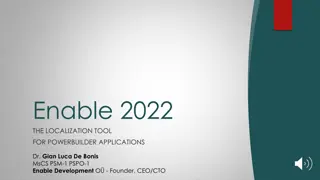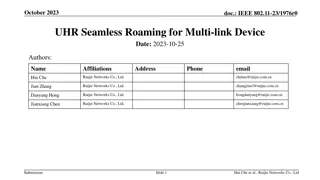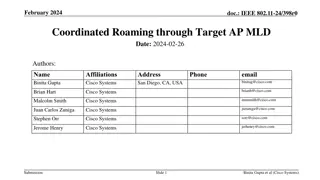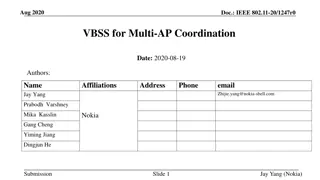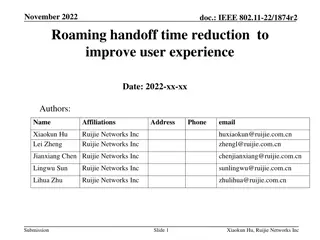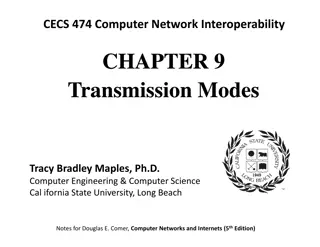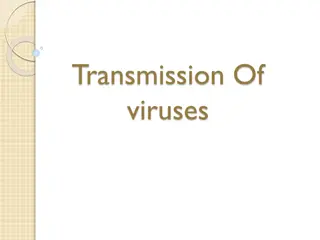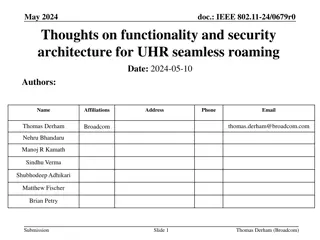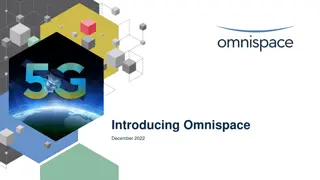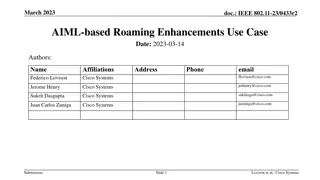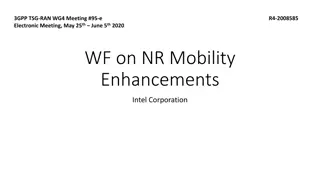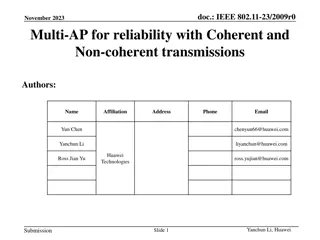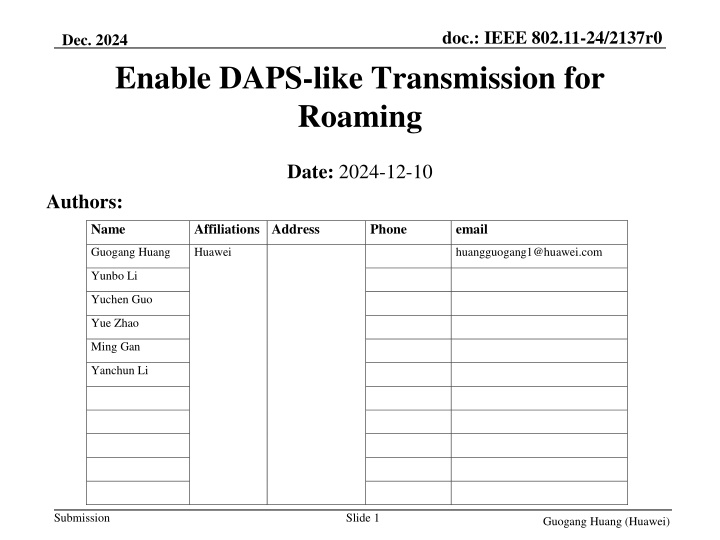
Enhancing Roaming Reliability with DAPS-like Transmission
"Learn about implementing DAPS-like transmission for IEEE 802.11bn roaming to ensure better link quality and performance during AP handovers. Explore the DAPS mechanism, its background, enabling process, and client-assisted transmission for improved efficiency."
Download Presentation

Please find below an Image/Link to download the presentation.
The content on the website is provided AS IS for your information and personal use only. It may not be sold, licensed, or shared on other websites without obtaining consent from the author. If you encounter any issues during the download, it is possible that the publisher has removed the file from their server.
You are allowed to download the files provided on this website for personal or commercial use, subject to the condition that they are used lawfully. All files are the property of their respective owners.
The content on the website is provided AS IS for your information and personal use only. It may not be sold, licensed, or shared on other websites without obtaining consent from the author.
E N D
Presentation Transcript
doc.: IEEE 802.11-24/2137r0 Dec. 2024 Enable DAPS-like Transmission for Roaming Date: 2024-12-10 Authors: Name Affiliations Address Phone email Guogang Huang Huawei huangguogang1@huawei.com Yunbo Li Yuchen Guo Yue Zhao Ming Gan Yanchun Li Submission Slide 1 Guogang Huang (Huawei)
doc.: IEEE 802.11-24/2137r0 Introduction During the roaming, one important observation is the link qualities with the current AP MLD and the target AP MLD fluctuate in a relatively large range due to the fast channel fading, obstacles or the user walking back and forth. This will cause the ping-pong roaming and result in a bad roaming performance. A DAPS (Dual Active Protocol Stack) mechanism has been defined for the roaming in the cellular network. (See next slide) which is very useful for the high-reliable application. In this contribution, we will discuss how to realize the DAPS-like transmission for 11bn roaming. Submission Slide 2 Guogang Huang (Huawei)
doc.: IEEE 802.11-24/2137r0 Background DAPS Defined in Cellular network To improve the roaming reliability, a DAPS transmission mechanism had been defined for the cellular network. It allows a UE can exchange the data with source node, target node, or both of them if the UE has more than one transceiver. Different keys are used to protect communications between the source node and the target node, respectively. Both DL and UL are considered. Figure. DL DAPS processing procedure at the receiver s side Figure. DL DAPS processing procedure at the transmitter s side Submission Slide 3 Guogang Huang (Huawei)
doc.: IEEE 802.11-24/2137r0 DAPS Enable The non-AP MLD can send a request to enable the DAPS transmission for one or more TIDs. If the associated AP MLD accepts this DAPS transmission request, it will duplicate each incoming MSDU (or A-MSDU) with an assigned SN and forward them to the target AP MLD. Before enabling the DAPS transmission, the non-AP MLD shall successfully establish the link(s) with the target AP MLD. Note for the distributed SMD, since the same PTKSA is used, then a PN is also assigned for each incoming MSDU (or A-MSDU) besides SN. Since there is no real-time BA sync between current AP MLD and target AP MLD, a duplicated transmission mode is normally adopted. In the following, we will propose a method to improve its transmission efficiency. Submission Slide 4 Guogang Huang (Huawei)
doc.: IEEE 802.11-24/2137r0 Client-assisted Transmission For the DL DAPS transmission, the non-AP MLD as the receiver can indicate which SNs of MSDUs are needed for transmission for current AP MLD and target AP MLD, respectively. Specifically, Firstly, the current AP MLD and target AP MLD as transmitters needs to report the info on the transmitter buffer, e.g. Current Max SN within the transmit buffer (labeled it as Info 1) Info 1 can be included within ICF, a newly defined A-Control field and the Multi- TID BAR frame Secondly, the non-AP MLD need to indicate SNs of MSDUs which are requested for transmission, e.g. SSN, Length (labeled it as Info 2) Info 2 can be included within ICR, a newly defined Poll frame and the Multi-STA BA frame Benefit. Reduce unnecessary duplicated transmissions and no requirement on the real-time BA sync between current AP MLD and target AP MLD [1-2]. Submission Slide 5 Guogang Huang (Huawei)
doc.: IEEE 802.11-24/2137r0 Client-assisted Transmission (Cont.) Transmit buffer of current AP Reordering buffer of non-AP MLD N 2 1 0 DS Link 1 Duplication Detection Current AP assigns a SN for each incoming MSDU, then duplicates and forwards it. Link 2 N 2 1 0 Non-ideal backhaul Transmit buffer of target AP Recipient Reordering Buffer Control Per TID (WinStart_B, WinSize_B) Originator 2 Originator 1 Transmit Buffer Control Per MLD/TID (WinStart_O#2, WinSize_O#2) Transmit Buffer Control Per MLD/TID (WinStart_O#1, WinSize_O#1) Scoreboard Context Control (WinStart_R, WinSize_R) Aggregation control Aggregation control Deaggregation control Multi-TID BAR(SSN#2, Max SN#2 ) Multi-STA BA(SSN#2, Bitmap; SSN#2 , Length#2) Multi-TID BAR(SSN#1, Max SN#1 ) Multi-STA BA(SSN#1, Bitmap; SSN#1 , Length#1) Info 2, which is used for submitting MPDUs for transmission Which is used for releasing transmit buffer Guogang Huang (Huawei) Submission Slide 6
doc.: IEEE 802.11-24/2137r0 Comments The proposed client-assisted transmission method also makes the NC AP MLD (also named centralized SMD) architecture possible. Because one of previous main concerns is the BA sync delay between the NC AP MLD upper MAC and lower MAC will significantly degrade the transmission efficiency of multiple non-collocated transmitters. By exploiting the proposed method, each AP MLD maintains a local transmit buffer and no need to further define the BA sync message between the current AP MLD and the target AP MLD [1-2]. DS NC AP MLD Upper MAC (e.g. MSDU, TID, GSN/SN) I/F AP MLD N AP MLD 1 AP MLD 0 Submission Slide 7 Guogang Huang (Huawei)
doc.: IEEE 802.11-24/2137r0 Conclusions The DAPS-like transmission is very useful to improve the reliability during the roaming. For transmission significantly improve the transmission efficiency. i.e. the client coordinates transmissions between the current AP MLD and the target AP MLD to reduce unnecessary duplicated transmissions as much as possible . the DAPS method transmission, is a client-assisted which proposed, can Submission Slide 8 Guogang Huang (Huawei)
doc.: IEEE 802.11-24/2137r0 References [1] 11-24-0778-00-00bn-nc-mlo-operation-issues [2] 11-25-0201-00-00bn-frame-processing-enhancements-for-tgbn Submission Slide 9 Guogang Huang (Huawei)
doc.: IEEE 802.11-24/2137r0 SP Do you support to define a DAPS mechanism which allows a non-AP MLD can simultaneously exchange data frames with the current AP MLD and the target AP MLD? Submission Slide 10 Guogang Huang (Huawei)
doc.: IEEE 802.11-24/2137r0 Appendix GSN-based DAPS Considering the following disadvantages of the proposed method of reusing the current SN, another option is to introduce a new global SN (GSN) on top of the existing MAC processing blocks . The proposed method may need to change the current chip architecture. For example, may need to add a buffer after the SN is assignment. This method is not flexible to do the A-MSDU operation, which highly depends on the operating BW and is done per affiliated AP. DS DS SAP Non-AP MLD Target AP MLD Current AP MLD MAC SAP MAC SAP Note. GSN is regarded as a part of the frame body, rather than a part of MPDU Header. Because all of related operations are achieved by software and no strict requirement on the processing time. GSNReordering Buffer GSN Scoreboarding, GSN Duplication Detection (Software) GSN Assignment (Software) <MSDU, TID, GSN> Existing 11be MLO UMAC processing Existing 11be MLO UMAC processing Existing 11be MLO UMAC processing Existing 11be MLO UMAC processing Existing 11be MLO LMAC processing Existing 11be MLO LMAC processing Existing 11be MLO LMAC processing Existing 11be MLO LMAC processing Figure. MAC Processing Procedure of DL DAPS-like Transmission Existing 11be MLO LMAC processing Existing 11be MLO LMAC processing Existing 11be MLO LMAC processing Existing 11be MLO LMAC processing Submission Slide 11 Guogang Huang (Huawei)
doc.: IEEE 802.11-24/2137r0 Appendix GSN-based DAPS(Cont.) GSN-based Transmit buffer of current AP MLD GSN assignment, duplication and forward Reordering buffer of non-AP MLD N 2 1 0 DS Link 1 Duplication Detection GSN-based Transmit buffer of target AP MLD Non-ideal backhaul Link 2 N 2 1 0 Recipient Originator 2 Originator 1 Reordering Buffer Control Per TID (WinStart_B ,WinSize_B ) Transmit Buffer Control Per non-MLD/TID (WinStart_O#1 , WinSize_O ) Transmit Buffer Control Per non-MLD/TID (WinStart_O#2 , WinSize_O ) Scoreboard Context Control Per TID (WinStart_R ,WinSize_R ) Transmit Buffer Control Per non-MLD/TID (WinStart_O#2, WinSize_O#2) Transmit Buffer Control Per non-MLD/TID (WinStart_O#1, WinSize_O#1) Scoreboard Context Control (WinStart_R#2,WinSize_R#2) Scoreboard Context Control (WinStart_R#1,WinSize_R#1) Aggregation control Aggregation control Deaggregation control Deaggregation control Multi-TID BAR(SSN#2, GSSN#2, Max GSN#2 ) Multi-STA BA(SSN#2, Bitmap; GSSN#2, Bitmap; GSSN#2 , Length#2) Multi-TID BAR(SSN#1, GSSN#1, Max GSN#1 ) Multi-STA BA(SSN#1, Bitmap; GSSN#1, Bitmap; GSSN#1 , Length#1) Which is used for releasing transmit buffer and submitting MPDUs for transmission Which is used for releasing GSN-based transmit buffer Info 2, which is used for submitting MSDUs for transmission Submission Slide 12 Guogang Huang (Huawei)

